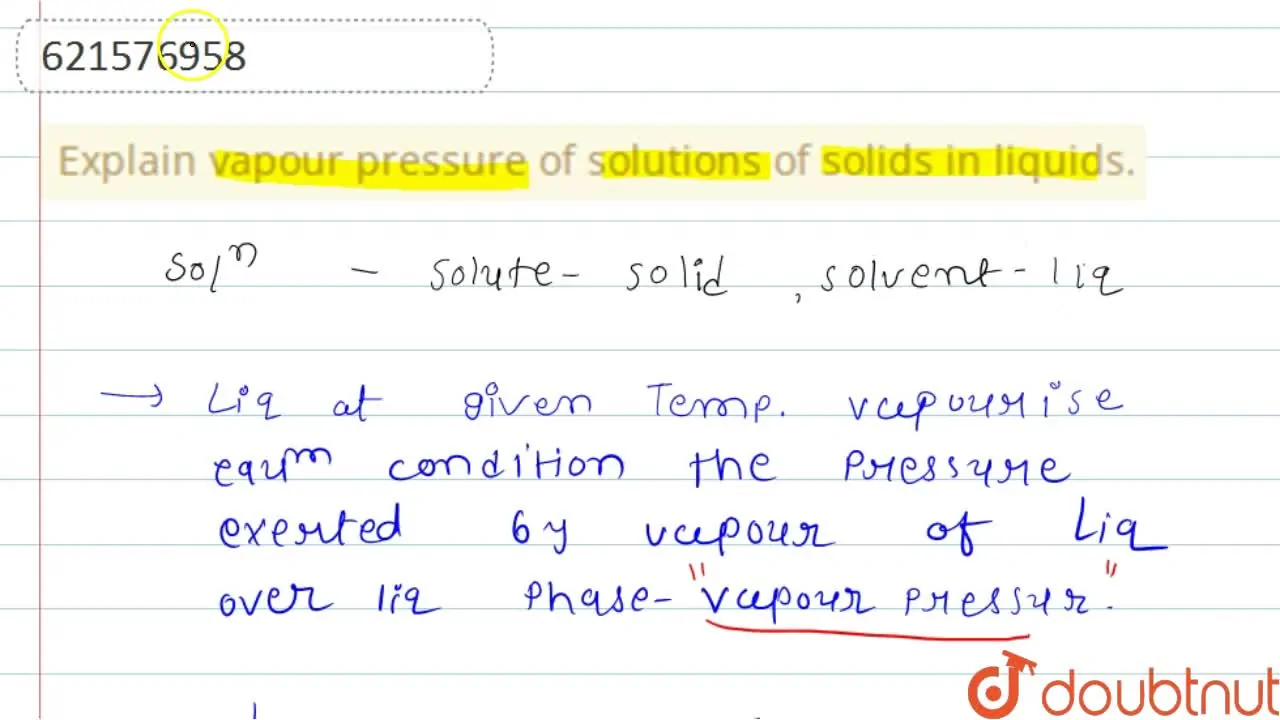Explain vapour pressure of solutions of solids in liquids. Solution in Gujrati
Liquids at a given temperature vapourise and under equilibrium conditions the pressure exerted by the vapours of the liquid over the liquid phase is called vapour pressure.

In a pure liquid the entire surface is occupied by molecules of the liquid. If anon - volatile solute is added to a solvent to given a solution, the vapour pressure of the solution is solely from the solvent alone.
This vapour pressure of the solution at a given temperature is found to be lower than the vapour pressure of the pure solvent at the same temperature. In the solution, the surface has both solute and solvent molecules, there by the fraction of the surface covered by the solvent molecules gets reduced. Consequently, the number of solvent molecules escaping from the surface is correspondingly reduced, thus, the vapour pressure is also reduced.
The decrease in the vapour pressure of solvent depends on the quantity of non - volatile solute present in the solution, irrespective of its nature.
Let p1 be the vapour pressure of the solvent, x1 be its mole fraction, p01 be its vapour pressure in the pure state. Then according to Raoult.s law p1∝x1 and p1=x1×p01
The proportionality constant is equal to the vapour pressure of pure solvent, p01.
A plot between the vapour pressure and the mole fraction of the solvent is linear.

Related Playlists
- BOOK - KUMAR PRAKASHANCHAPTER - SOLUTIONS EXERCISE - SECTION - A QUESTIONS (SELF - PRACTICE QUESTIONS)37videos
SOLUTIONS
- BOOK - KUMAR PRAKASHANCHAPTER - SOLUTIONS EXERCISE - SECTION - A QUESTIONS (TRY YOURSELF)29videos
SOLUTIONS
- BOOK - KUMAR PRAKASHANCHAPTER - SOLUTIONS EXERCISE - SECTION - E MCQs asked in GUJCET/Board Exam69videos
SOLUTIONS
- BOOK - KUMAR PRAKASHANCHAPTER - SAMPLE QUESTION PAPER EXERCISE - [PART-B] SECTION - C2videos
SAMPLE QUESTION PAPER
- BOOK - KUMAR PRAKASHANCHAPTER - SURFACE CHEMISTRYEXERCISE - SECTION - E (MCQs asked in GUJCET/Board Exams)52videos
SURFACE CHEMISTRY
Similar Questions
Given examples of gaseous solute and solvent.
09:09View SolutionIf 5.85 gm of NaCl is dissolved in 90 gm of water, then find out the mole fraction of NaCl.
02:08View SolutionFreezing point of urea solution is −0.60C. How much urea is required to be dissolved in 3 kg water ? [M(urea)=60gmol−1,Kf=1.50C Kg mol−1]
02:14View Solution0.6 ml acetic and having the density 1.06 g mL−1 is dissolved in 1 litre water. It's shows the depression in freezing point of 0.020.5∘C. Calculate want haff factor and Ka of an acid.
02:54View SolutionName the catalyst [X] for the reaction,
CO(g)+H2(g)[X]−−→HCHO(g)View SolutionSOLID-LIQUID EQUILIBRIUM, LIQUID-VAPOUR EQUILIBRIUM AND SOLID-VAPOUR EQUILIBRIUM
02:14View SolutionA temperature at which the vapour pressure of a solid is equal to the vapour pressure of liquid is called _______.
52:26View SolutionThe vapour pressure of a solution having solid as solute and liquid as solvent is:
02:44View Solutionexplain solid solution ,Liquid solution and Gaseous solution .
03:22View SolutionThe vapour pressure of a solution having solid as solute and liquid as solvent is:
03:01View SolutionThe vapour pressure of a solution having solid as solute and liquid as solvent is:
29:59View SolutionVapour pressure and Raoult law-Numericals | Raoult Law As Special Case Of Henry Law | Vapour Pressure of Solutions of Solids in Liquids
26:32View SolutionExplain ''Solubility of gaseous solute and vapour pressure of liquid solution follows Henry's and Raoult's law''.
42:17View SolutionExplain vapour pressure of liquid.
02:23View SolutionA temperature at which the vapour pressure of a solid is equal to the vapour pressure of liquid is called _______.
42:11View Solution


